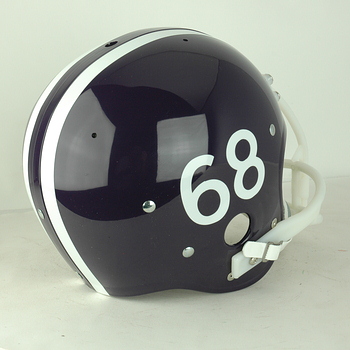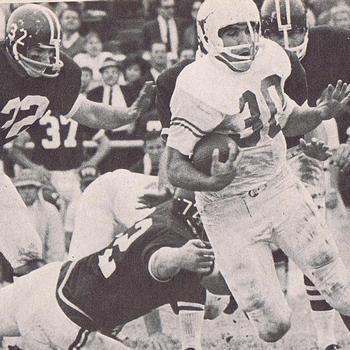

TEXAS CHRISTIAN UNIVERSITY
1968 Horned Frogs
(Authentic Reproduction)
|
|
|
For those who followed the
fortunes of the former Southwest Conference, it often appeared as if the almost
exclusively Texas based, football-crazed conglomerate completed their own brand
of annual fratricide. The competitive nature of Texas high school football
provided enough players for even the mammoth program at the University Of Texas
to recruit within the borders of the state with little need to look elsewhere.
With the number of scholarships limited only by financial resources, the smaller
schools or those with less stature than perennial conference big boys Texas and
Texas A&M, often boasted of “All Texas-bred” rosters. Texas Christian
University, the first coed college in the southwestern part of the United States
that could trace its founding to the post-Civil War era, could also trace a
rather broad ranging history on the gridiron. They knew the boundaries of the
sport’s terrain from the top of the mountain where the 1930’s brought National
Championships, bowl appearances, a Heisman Trophy winner, and numerous All
Americans, to the nadir of non-productive zero, one, and two win seasons that
lasted for many consecutive years. TCU had a second revival of solid, and often
feared squads through the 1950’s and were always viewed as an upset contender
through the ‘60’s. Blessed with legendary coaching from Leo “Dutch” Meyer from
1934 through ’52, the reins were handed to Othol Hershel “Abe” Martin for
another lengthy run that lasted through the 1966 season. The folksy Martin had
been a member of TCU’s first Southwest Conference championship team of 1929 and
became one of the most highly respected high school coaches in Texas. Returning
to his alma mater in 1945 as a Meyer assistant, he moved to the head coaching
chair in ‘53 and brought the Horned Frogs to three Cotton Bowl appearances. His
teams earned a reputation as hard-nosed competitors who excelled at the big
upset and he maintained the tradition of emphasizing the primary school color of
purple. Throughout most of his tenure, the Frogs donned purple Riddell TK shells
with a one-inch white center stripe, with or without player numerals on both
sides. For the 1960 through ’64 seasons, Martin unveiled a white helmet with
black identification numerals that were never as popular as the purple shells so
he returned to the traditional helmet color with white center stripe in 1965,
and introduced a horned frog decal on the sides.
|
|
 |
Successive middle of the pack
finishes culminating in an unexpectedly poor 2-8 season in 1966, perhaps made
Martin finally realize that the glory days of TCU football were behind him, and
with health concerns to address, he retired from the sideline after the ‘66
season and focused exclusively upon his role as AD. Former Frog standout Fred
Taylor, who had earned the reputation as a tough disciplinarian while a
fourteen-year assistant to Martin, was elevated to the head coach position.
Taylor's debut 1967 4-6 season was full of offensive woes, putting up but
sixteen points in the first five games and suffering three consecutive shutouts.
The offensive talent was there, especially in running backs Steve Landon, Kenny
Post, sprinter Norm Bulaich, and Ross Montgomery who rushed for 739 yards and
Taylor maintained TCU’s upset tradition with a great 24-17 victory over heavily
favored Texas. Taylor, like most new coaches put his mark on the uniform by
discarding the frog logo and opting for a noticeable “cTu” on both sides of the
purple shell that very much mimicked the logo of rival Texas A&M.
|
|
 |
In 1968 the addition of Trinity Valley (TX) Community College standout Linzy
Cole, the first African-American to play for TCU, was supposed to help the
receiving corps but again the offense was sluggish a good deal of the time
resulting in a 3-7 mark. Guard James Ray and Center John Ruthstrom were fine
players and the backs were still loaded with talent with an oft-injured
Bulaich and big 220-pound Montgomery the best of them. Montgomery went on to
two disappointing seasons with the Bears while Bulaich later had a ten year
NFL career. Linebacker James Vanderslice played at an All Conference level
at linebacker but it was noseguard Larry Adams that was named to the All SWC
team, and the defense only allowed two games to get out of hand. For the ’68
season, Head Coach Taylor returned to what had been TCU’s traditional
uniform appearance. He placed two three-quarter-inch white flanking stripes
on the helmet, and restored the white player identification numerals to the
sides. The numerals stood out as they were two-and-one-half inches which
were a bit larger than the standard look of the day and extended to the ear
hole of the helmet shell. With most of the players using white plastic Adams
masks, the Frogs had a distinctive appearance on the field.
Two subsequent four win seasons found Taylor leaving and the respected Jim Pittman taking over as head coach. Tragically, Pittman died on the sidelines of the October 30, 1971 contest against Baylor, which began a slide in Horned Frog fortunes that lasted throughout the remainder of the 1970’s and into the mid-eighties. Of course in recent seasons, TCU has again become a highly respected, bowl bound opponent under the leadership of Gary Patterson with the traditional purple prominent on their uniforms.